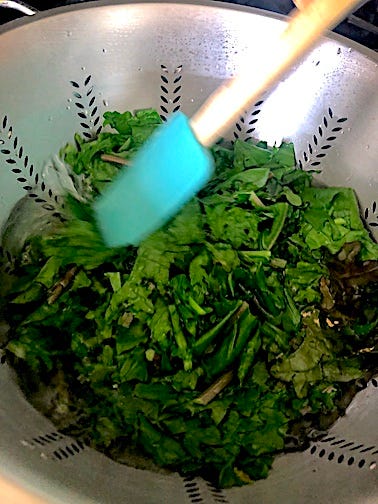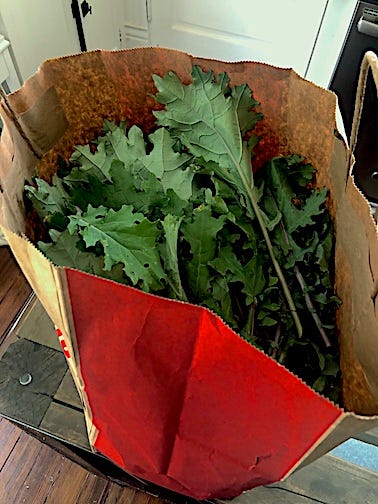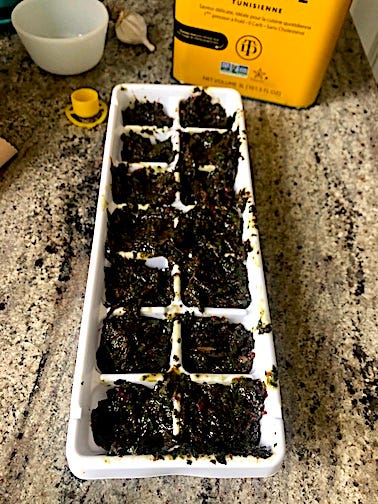Garden-based eating at summer's peak
What to do with all that kale, Swiss chard, and carrot?
By Lisa Brunette
It’s about this time of year that we gardeners look around at our yard (or allotment, for you Brits) and feel like it has a mind of its own.
The neat paths we filled in with wood chips in April are now studded with plants we did not plant. The orderly vegetable rows are no more; the cucumber vines pull down the kale, its leaves tattering, and the pumpkin creeps into the garlic, which we would go on and harvest if it would only stop raining and dry up a bit.
But we’re glad for the rain, as it’s a relief from this drought. According to the Missouri Division of Fire Safety, more than 24 percent of the state is at “extreme drought” status.
And we’re glad for nature’s abundance, despite the drought, even if that abundance can feel a bit overwhelming at times. It’s with that feeling that I went out and processed a mess o’ greens.
If you’re in zone 6A, especially, let me recommend two for you:
Southern Exposure Seed Exchange’s ‘Red Russian’ kale
Seed St. Louis’ ‘Bright Lights’ Swiss chard
They are hardy and prolific, and the only problem you’ll have is figuring out what to do with them all. Both greens are delicious sautéd, of course, whether that’s in water, broth, bacon grease, animal fat, or olive or coconut oil. It’s best to serve them while the color is still bright rather than cooking them down too much, to mush.
After that, though, what else for these greens, if you want to preserve them for later use? Through some trial and error, I’ve found Swiss chard is perfect dehydrated and saved in jars for winter stews and soups, especially slow cooked in a crockpot. And kale is great for kale chips. Kale is also a good one to blanch and freeze.
We have a behemoth electric dehydrator from olden times, and it gets a workout. It’s an American Harvest Snackmaster, and that’s still a brand you can purchase via a company called Nesco, though I don’t know the history there and if the quality is still what it was. The ratings suggest it is? If you can trust the ratings.


All I do for the Swiss chard is chop it up and dehydrate until the leaves and especially the stems are completely dry. I’m also trying Swiss chard pesto cubes, but the red in them turns the color a bit off. Maybe that’s OK if the taste is there? To do this, you leave out the nuts and cheese but make the pesto otherwise the same way, with lemon juice, olive oil, and garlic. Then freeze it in an ice cube tray; the cubes are really handy in the winter when you want something green. Or in this case, greenish.
Kale chips are a little more involved. I’ll share a recipe for those on Saturday for paid subscribers.
To blanch kale, you plunk it down into a pot of boiling water; this is just enough to turn it bright green. Then it goes into a bowl of ice water to stop it from cooking. Then freeze.


Did you know we have a referral program that rewards readers who refer their friends to Brunette Gardens?
Now let’s talk about those carrots.
I’m not sure carrots get enough due as a garden food plant. They’re surprisingly easy to grow if you get the right carrot for your conditions. And you can, depending on your zone, grow two crops per year: one in spring and another in fall.
Carrots from the garden are like tomatoes from the garden: They just taste better than store bought. More carrot-y. Fresher. Less fibrous. Crunchier!
I’ll admit I was a sucker for the fancy purple carrots when I first started out. But I’ve learned my lesson and now stick to two blocky varieties that work well in our Midwestern clay soil:
Seed St. Louis’ ‘New Kuroda’
Southern Exposure Seed Exchange’s ‘Chantenay Red Core’
For instructions for how to grow carrots, plus a tasty recipe for carrot salad and tips on pickling them, check out the below post. And here you can see why those purple ones don’t work for us. They go spindly.
If you're not growing carrots, you don't know what's up, doc
By Lisa Brunette This is our third year growing carrots, and we're happy to report the vibrant root veg has earned a permanent place in our home garden. Why? So. Many. Reasons… Easy to Grow First, carrots are surprisingly easy to grow. You just have to pick the right variety. Here in the Midwest, the car…
Our garlic and onions are ready to harvest, by the way, but the ground’s still too wet. We planted both of these last fall, which is a method that really works for us. You can read about that in this post if you’re interested in ordering bulbs now for your own fall planting:
The awesomeness of alliums
By Lisa Brunette So far this late summer, I’ve encouraged you to plant now for a fall crop of carrots as well as put in some asparagus, the perfect perennial for years of spears to come. This time I want to talk about alliums. There are hundreds of species in the plant genus allium, but the two I suggest embracing in your garden are g…
What abundance are you currently thankful for, and wrestling with? I’d love to hear of your own garden-based eating, especially if it goes beyond the typical summer tomatoes and corn!
There are two affiliate links in this post, for the dehydrator and Nesco. If you purchase using those links, Brunette Gardens might earn a small commission, at no extra cost to you. See more on our Notices & Policies page.









I harvested about 30lbs of food yesterday, beets, zucchini, kohl rabi, basil, carrots, cukes. Something is eating the tops of my beets, we think it is a chipmunk but whatever it is is not interested in the peanut butter in the live trap. It is definitely a rodent. The basil I processed with olive oil, later this summer I will gather pine nuts.
Good to know it's not just me getting overwhelmed by the growth ( and the weeds) at this time of year! Because of our long dry hot spell earlier, we're a bit behind. I harvested the currants and gooseberries today, well the ones left behind by the blackbird family which worked out how to get under the netting. Thanks for the tip on drying chard, will definitely do that later this year!